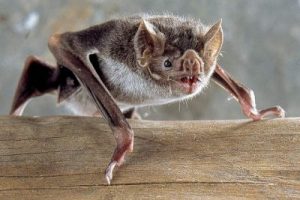The Common Vampire Bat, Desmodus Rotundus
Having been on the scene for 20 million years, the common vampire bat of South America has become increasingly intelligent, perceptive and highly sociable. It is little, up to 9 centimetres (3.5 inches) long. It feeds nightly on four times its weight in blood drained mostly from domesticated animals, in order to fly at the startling speed of 13.2 kilometres an hour (8.59 miles per hour), and to run at 1.77 kilometres an hour (1.1 miles per hour) for up to 90 minutes.
Uniquely for a mammal, the common vampire bat draws its enormous energy directly and speedily from amino-acids derived from its richly proteinous diet. If it does not feed for three days it will die, and so a fully topped up bat will share it’s bellyful with one of its needy fellow colonists.
The following paragraph will not please the squeamish
As the vampire bat is entirely nocturnal, it waits for the moon to descend before hunting , locating its prey with its acute hearing through the soft sounds of sleepy breathing. Having landed on the ground nearby, the bat carefully stalks its chosen victim – walking, hopping, when necessary running. Through heat sensors at the end of its tipped up snout, it quickly detects any accessible area of skin with a fulsome blood supply. Any hair on the skin which could interfere with the prospective feed is steadily licked off before the bat makes accurate incisions with its two razor sharp tiny triangular teeth. The bat’s saliva, its “venom”, contains powerful anticoagulants and vasodilators which ensure a continuous and copious clot-free flow of blood. One of these bio-active ingredients is called Draculin. The grooves on the tongue help to direct the lapped stream of blood into the back of the throat for swallowing into its super-elastic stomach.
***
And, yes, the common vampire bat does feed on human blood if obliged. And, yes, it can transmit rabies. It is predicted that the vampire bat will soon follow hard on the heels of global warming into southern states of North America.
***
“How blessed are some people, whose lives have no fears, no dreads; to whom sleep is a blessing that comes nightly, and brings nothing but sweet dreams”
Abraham “Bram” Stoker (1847 – 1912)
Irish Bram Stoker was responsible for the turgid tale of “Dracula”. Published in 1897 it was a thoroughly disconcerting account of the “evil” Count Dracula and his acolytes versus the “good” men of the Crew of Light. Count Dracula, of course, is the sinister male vampire living in his Transylvanian castle with his three attendant fawning females who have been bitten, died and reincarnated as lookalike but now sexually aggressive young vampires.
Stoker’s naïve young hero, the London estate agent Jonathan Harker, visits his client Count Dracula to complete on a property deal. Silly boy.
“The rest is history”, as my Granny would say.
Through many decades of reiteration, Count Dracula has remained well known to this day as The Vampire, but I suspect few will have read Stoker’s nasty novel from cover to cover voluntarily. Its main theme is the good men’s vicious and bloody battle against vampirism as expressed in female sexual dominance. The newly minted Victorian middle class male reckoned he owned his wife’s body – let alone her dowry. The woman’s mundane sacred duties were firmly established – to procreate and to provide a clean home, to prepare meals and to raise her children.
Man must be pleased; but him to please
Is woman’s pleasure; down the gulf
Of his condoled necessities
She casts her best, she flings herself.
The Angel in the House, 1854, Coventry Patmore (1823 – 1896)
Bram Stoker was from a rigidly protestant Irish family. Three of his brothers were distinguished doctors in Ireland, and his sister married another. Bram became the business manager to the superstar actor, Sir Henry Irving, and ran Irving’s Lyceum Theatre in London’s West End. He became well acquainted with the louche high society of the time, and would have observed first hand its devil-may-care behaviour – a stark contrast to his own upbringing.
***
Way before Dracula was dreamt up, vampires were an important part of Central Europe’s mythology. A thousand years ago “vampires” were ghosts which brought fatal illnesses to those they touched. Transylvanian phantoms seeped insidiously into Western Europe’s folklore, causing on the way outbreaks of mass hysteria, and the execution and staking in the grave of any woman perceived to be a vampire.
I don’t know about you, but when I was very small, I would have a quick look under my bed for beasties before being persuaded to go to sleep – with a nightlight. I don’t think our children did that as there was little fear by then of finding anything in the least vampire-like. Following the Spanish flu of 1918, the sudden onset of fatal infectious disease had become scarce until the arrival of COVID.
Anxiety, stresses and worries inevitably provoke the secretion of adrenaline. Adrenaline prevents sleep. Lack of sleep subdues the secretion of testosterone – in both sexes. Lack of testosterone provokes the secretion of adrenaline – hence, more often than not, chronic insomnia. “A ruffled mind makes a restless pillow” – my Granny again.
Diseases or not, there are increasing causations of stress and anxiety, and these, along with the tide of overweight and obesity swamping the population, are creating a desexualised society.
The replacement fertility rate is roughly 2.1 live births per woman for most industrialised countries (PMID 25489464). In 2022, there were 1.5 births per woman in the UK (World Bank) – almost 1% less so far this year.
Of course, there are many reasons for zero population increases, not the least being affluence – or rather the desperate need to be affluent, despite the best efforts of greedy governments. Too tired, too little time, better things to do. Not enough thought is even given to “routine” sex when both partners are bombed out – it will have to wait – until Christmas. Ho-Ho!
But, waiting too long will result in lack of fertility and lack of libido due to naturally falling sex hormones. Testosterone production, please do not forget, is also significantly subdued by stress, anxiety, excess alcohol, overweight and obesity, lack of adequate sleep, prior testicular trauma and treatments of malignancy.
As 65% of the UK population is overweight or obese, of the remaining causations, most could be described as secondary. There are now miraculously effective appetite suppressants, but they are expensive and require monitoring, neither of which will be attractive to the over-burdened National Health Service. There is a step that the government could take if ever it could find the courage – banning ultra-processed foods.
CHRISTMAS PUD IS FINE





